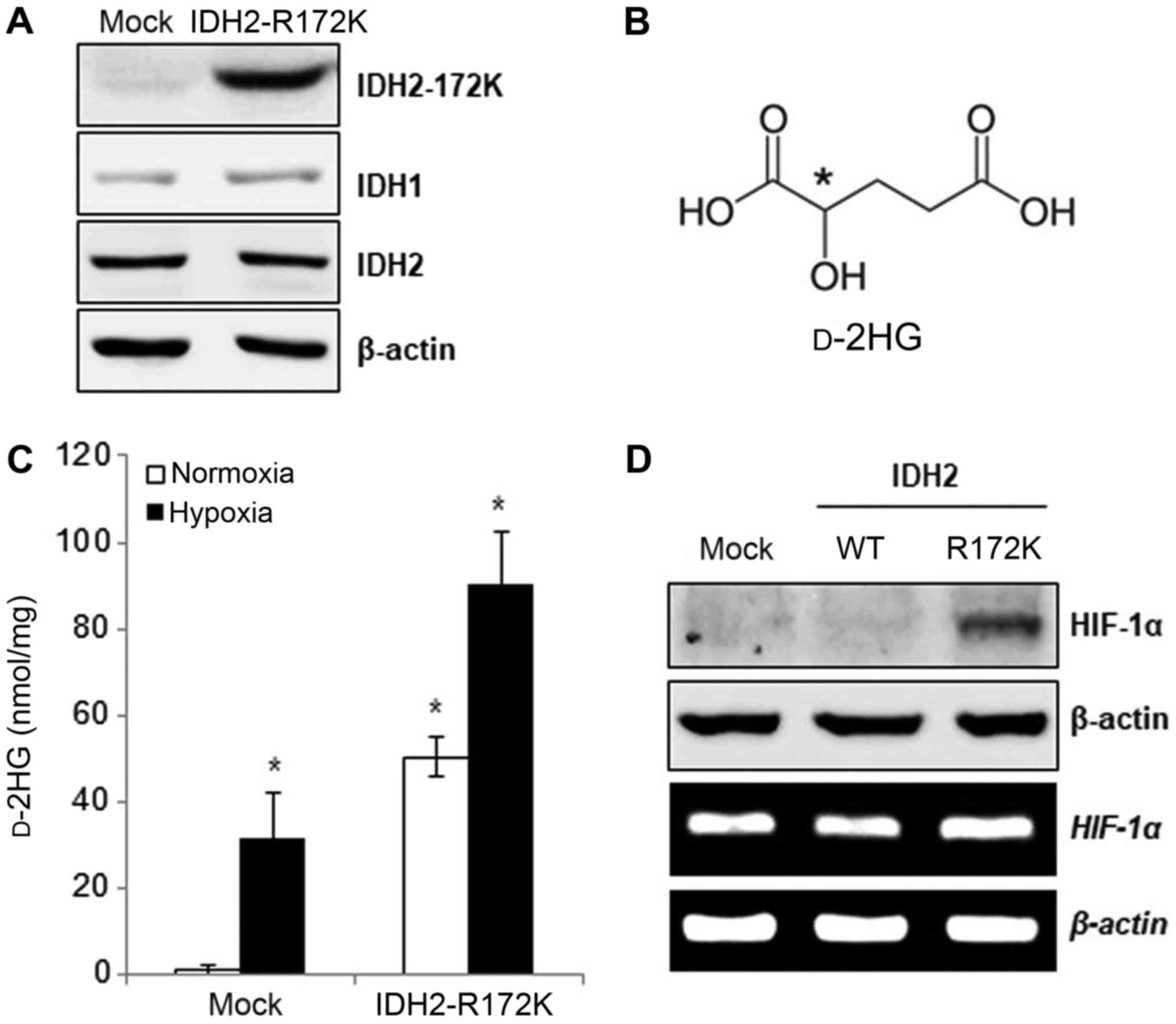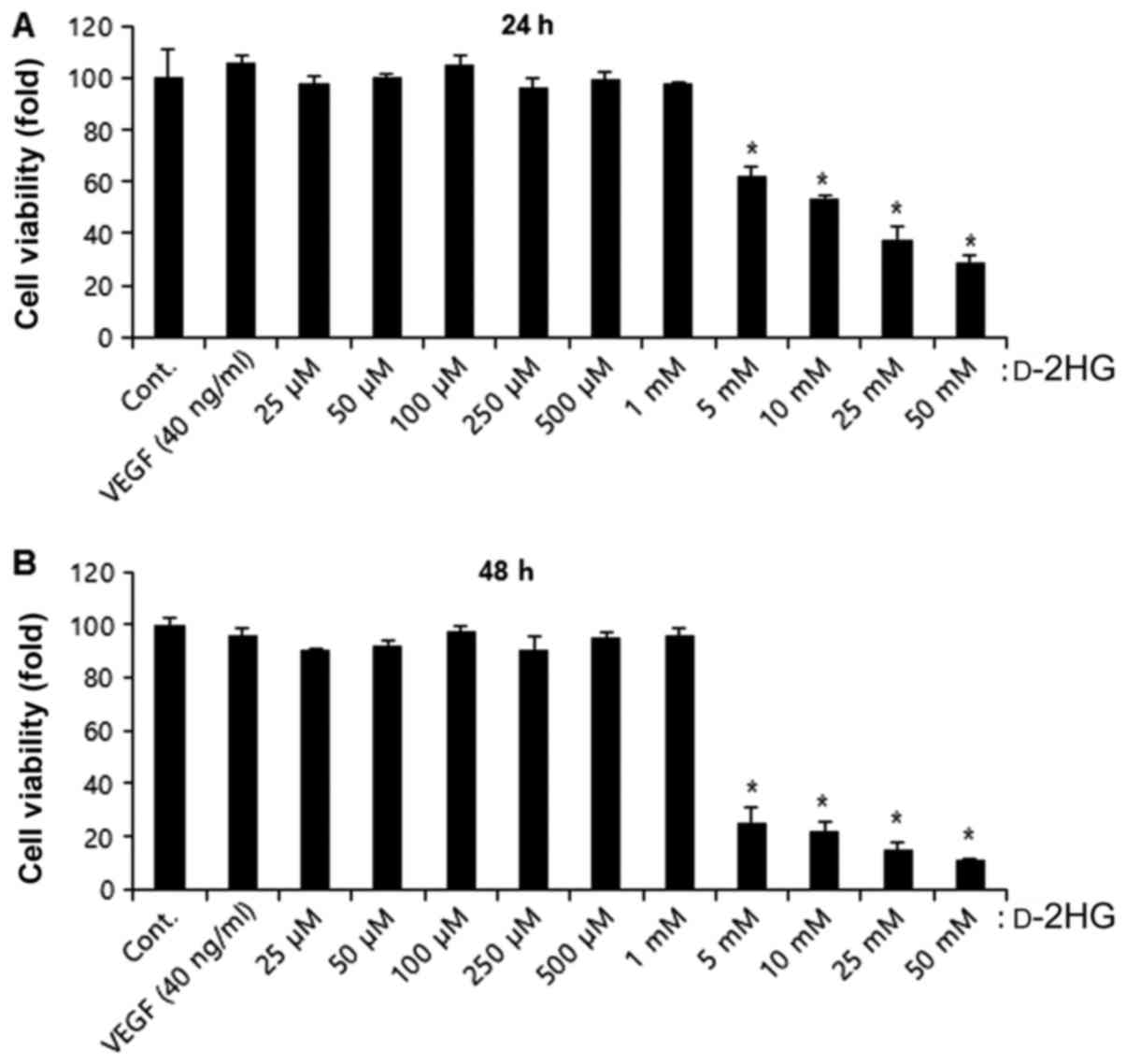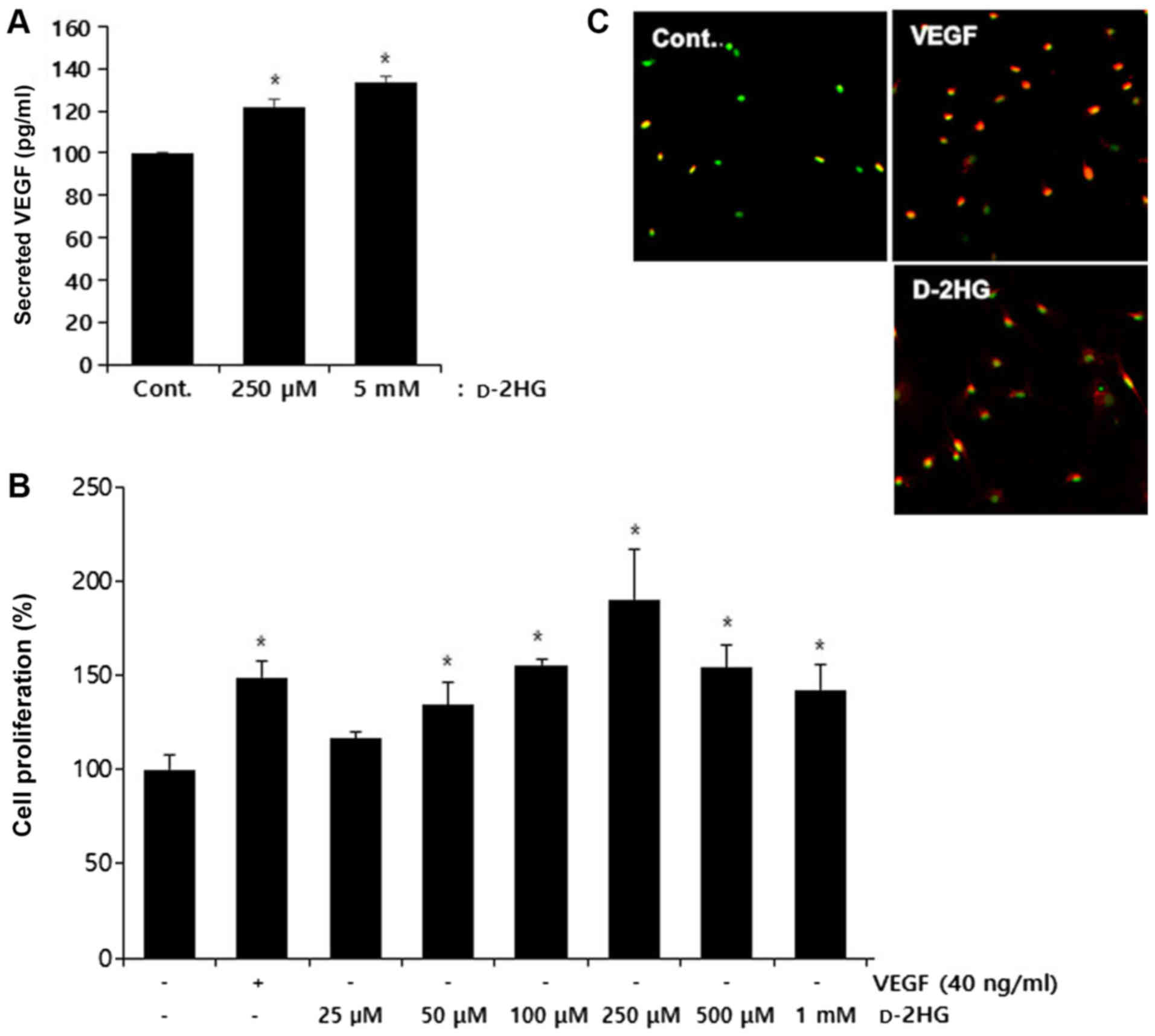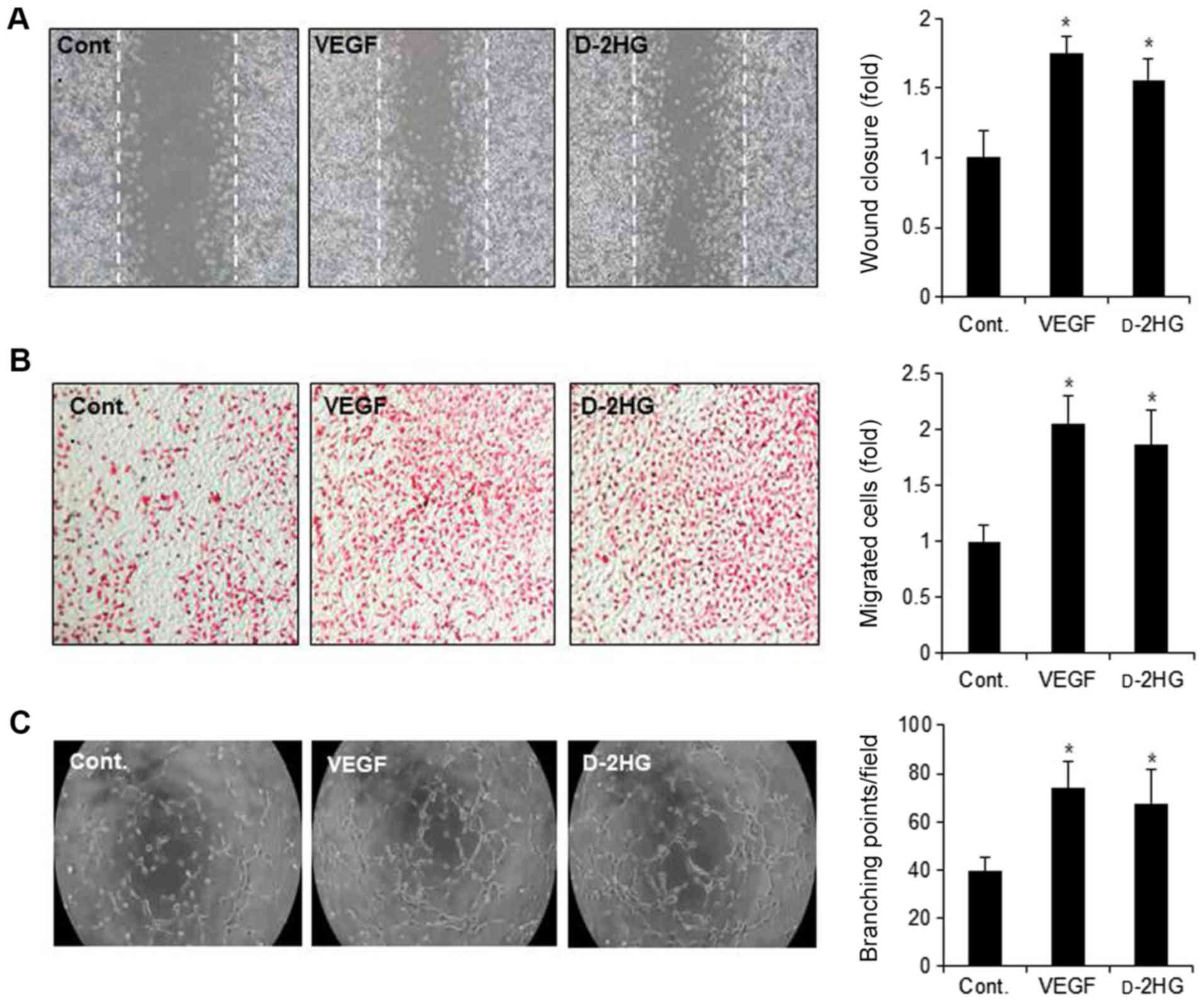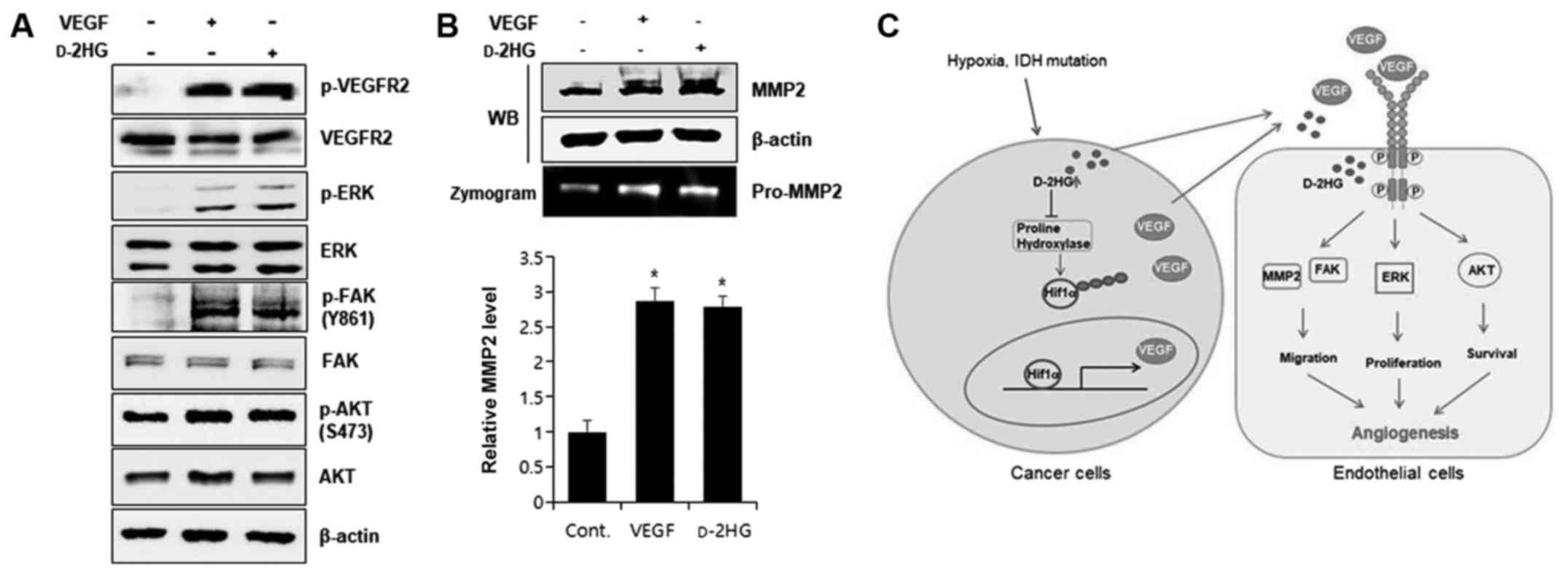|
1
|
McKeown SR: Defining normoxia, physoxia
and hypoxia in tumours-implications for treatment response. Br J
Radiol. 87:201306762014. View Article : Google Scholar : PubMed/NCBI
|
|
2
|
Bertout JA, Patel SA and Simon MC: The
impact of O2 availability on human cancer. Nat Rev
Cancer. 8:967–975. 2008. View Article : Google Scholar : PubMed/NCBI
|
|
3
|
Seok JK, Lee SH, Kim MJ and Lee YM:
MicroRNA-382 induced by HIF-1α is an angiogenic miR targeting the
tumor suppressor phosphatase and tensin homolog. Nucleic Acids Res.
42:8062–8072. 2014. View Article : Google Scholar : PubMed/NCBI
|
|
4
|
Folkman J: Role of angiogenesis in tumor
growth and metastasis. Semin Oncol. 29(Suppl 16): S15–S18. 2002.
View Article : Google Scholar
|
|
5
|
Ferrara N and Kerbel RS: Angiogenesis as a
therapeutic target. Nature. 438:967–974. 2005. View Article : Google Scholar : PubMed/NCBI
|
|
6
|
Vander Heiden MG, Cantley LC and Thompson
CB: Understanding the Warburg effect: The metabolic requirements of
cell proliferation. Science. 324:1029–1033. 2009. View Article : Google Scholar : PubMed/NCBI
|
|
7
|
Warburg OPK and Negelein E: The metabolism
of tumors. Biochem Z. 152:319–344. 1924.In German.
|
|
8
|
Losman JA and Kaelin WG Jr: What a
difference a hydroxyl makes: Mutant IDH, (R)-2-hydroxyglutarate,
and cancer. Genes Dev. 27:836–852. 2013. View Article : Google Scholar : PubMed/NCBI
|
|
9
|
Warburg O: On the origin of cancer cells.
Science. 123:309–314. 1956. View Article : Google Scholar : PubMed/NCBI
|
|
10
|
Cairns RA, Harris IS and Mak TW:
Regulation of cancer cell metabolism. Nat Rev Cancer. 11:85–95.
2011. View Article : Google Scholar : PubMed/NCBI
|
|
11
|
Raimundo N, Baysal BE and Shadel GS:
Revisiting the TCA cycle: Signaling to tumor formation. Trends Mol
Med. 17:641–649. 2011. View Article : Google Scholar : PubMed/NCBI
|
|
12
|
Wise DR, Ward PS, Shay JE, Cross JR,
Gruber JJ, Sachdeva UM, Platt JM, DeMatteo RG, Simon MC and
Thompson CB: Hypoxia promotes isocitrate dehydrogenase-dependent
carboxylation of α-ketoglutarate to citrate to support cell growth
and viability. Proc Natl Acad Sci USA. 108:19611–19616. 2011.
View Article : Google Scholar
|
|
13
|
Zhang C, Moore LM, Li X, Yung WK and Zhang
W: IDH1/2 mutations target a key hallmark of cancer by deregulating
cellular metabolism in glioma. Neuro-oncol. 15:1114–1126. 2013.
View Article : Google Scholar : PubMed/NCBI
|
|
14
|
Reitman ZJ and Yan H: Isocitrate
dehydrogenase 1 and 2 mutations in cancer: Alterations at a
crossroads of cellular metabolism. J Natl Cancer Inst. 102:932–941.
2010. View Article : Google Scholar : PubMed/NCBI
|
|
15
|
Parsons DW, Jones S, Zhang X, Lin JC,
Leary RJ, Angenendt P, Mankoo P, Carter H, Siu IM, Gallia GL, et
al: An integrated genomic analysis of human glioblastoma
multiforme. Science. 321:1807–1812. 2008. View Article : Google Scholar : PubMed/NCBI
|
|
16
|
Mardis ER, Ding L, Dooling DJ, Larson DE,
McLellan MD, Chen K, Koboldt DC, Fulton RS, Delehaunty KD, McGrath
SD, et al: Recurring mutations found by sequencing an acute myeloid
leukemia genome. N Engl J Med. 361:1058–1066. 2009. View Article : Google Scholar : PubMed/NCBI
|
|
17
|
Amary MF, Bacsi K, Maggiani F, Damato S,
Halai D, Berisha F, Pollock R, O'Donnell P, Grigoriadis A, Diss T,
et al: IDH1 and IDH2 mutations are frequent events in central
chondrosarcoma and central and periosteal chondromas but not in
other mesenchymal tumours. J Pathol. 224:334–343. 2011. View Article : Google Scholar : PubMed/NCBI
|
|
18
|
Chan-On W, Nairismägi ML, Ong CK, Lim WK,
Dima S, Pairojkul C, Lim KH, McPherson JR, Cutcutache I, Heng HL,
et al: Exome sequencing identifies distinct mutational patterns in
liver fluke-related and non-infection-related bile duct cancers.
Nat Genet. 45:1474–1478. 2013. View Article : Google Scholar : PubMed/NCBI
|
|
19
|
Cairns RA, Iqbal J, Lemonnier F, Kucuk C,
de Leval L, Jais JP, Parrens M, Martin A, Xerri L, Brousset P, et
al: IDH2 mutations are frequent in angioimmunoblastic T-cell
lymphoma. Blood. 119:1901–1903. 2012. View Article : Google Scholar : PubMed/NCBI
|
|
20
|
Fassan M, Simbolo M, Bria E, Mafficini A,
Pilotto S, Capelli P, Bencivenga M, Pecori S, Luchini C, Neves D,
et al: High-throughput mutation profiling identifies novel
molecular dysregulation in high-grade intraepithelial neoplasia and
early gastric cancers. Gastric Cancer. 17:442–449. 2014. View Article : Google Scholar
|
|
21
|
Sjöblom T, Jones S, Wood LD, Parsons DW,
Lin J, Barber TD, Mandelker D, Leary RJ, Ptak J, Silliman N, et al:
The consensus coding sequences of human breast and colorectal
cancers. Science. 314:268–274. 2006. View Article : Google Scholar : PubMed/NCBI
|
|
22
|
Kang MR, Kim MS, Oh JE, Kim YR, Song SY,
Seo SI, Lee JY, Yoo NJ and Lee SH: Mutational analysis of IDH1
codon 132 in glioblastomas and other common cancers. Int J Cancer.
125:353–355. 2009. View Article : Google Scholar : PubMed/NCBI
|
|
23
|
Ye D, Ma S, Xiong Y and Guan KL:
R-2-hydroxyglutarate as the key effector of IDH mutations promoting
oncogenesis. Cancer Cell. 23:274–276. 2013. View Article : Google Scholar : PubMed/NCBI
|
|
24
|
Mondesir J, Willekens C, Touat M and de
Botton S: IDH1 and IDH2 mutations as novel therapeutic targets:
Current perspectives. J Blood Med. 7:171–180. 2016. View Article : Google Scholar : PubMed/NCBI
|
|
25
|
Xu W, Yang H, Liu Y, Yang Y, Wang P, Kim
SH, Ito S, Yang C, Wang P, Xiao MT, et al: Oncometabolite
2-hydroxyglutarate is a competitive inhibitor of
α-ketoglutarate-dependent dioxygenases. Cancer Cell. 19:17–30.
2011. View Article : Google Scholar : PubMed/NCBI
|
|
26
|
Molenaar RJ, Radivoyevitch T, Maciejewski
JP, van Noorden CJ and Bleeker FE: The driver and passenger effects
of isocitrate dehydrogenase 1 and 2 mutations in oncogenesis and
survival prolongation. Biochim Biophys Acta. 1846:326–341.
2014.PubMed/NCBI
|
|
27
|
Dang L, Jin S and Su SM: IDH mutations in
glioma and acute myeloid leukemia. Trends Mol Med. 16:387–397.
2010. View Article : Google Scholar : PubMed/NCBI
|
|
28
|
Colvin H, Nishida N, Konno M, Haraguchi N,
Takahashi H, Nishimura J, Hata T, Kawamoto K, Asai A, Tsunekuni K,
et al: Oncometabolite D-2-Hydroxyglurate directly induces
epithelial-mesenchymal transition and is associated with distant
metastasis in colorectal cancer. Sci Rep. 6:362892016. View Article : Google Scholar : PubMed/NCBI
|
|
29
|
Koivunen P, Lee S, Duncan CG, Lopez G, Lu
G, Ramkissoon S, Losman JA, Joensuu P, Bergmann U, Gross S, et al:
Transformation by the (R)-enantiomer of 2-hydroxyglutarate linked
to EGLN activation. Nature. 483:484–488. 2012. View Article : Google Scholar : PubMed/NCBI
|
|
30
|
Intlekofer AM, Dematteo RG, Venneti S,
Finley LW, Lu C, Judkins AR, Rustenburg AS, Grinaway PB, Chodera
JD, Cross JR, et al: Hypoxia induces production of
L-2-hydroxyglutarate. Cell Metab. 22:304–311. 2015. View Article : Google Scholar : PubMed/NCBI
|
|
31
|
Hur W, Ryu JY, Kim HU, Hong SW, Lee EB,
Lee SY and Yoon SK: Systems approach to characterize the metabolism
of liver cancer stem cells expressing CD133. Sci Rep. 7:455572017.
View Article : Google Scholar : PubMed/NCBI
|
|
32
|
Lee SH, Jung YD, Choi YS and Lee YM:
Targeting of RUNX3 by miR-130a and miR-495 cooperatively increases
cell proliferation and tumor angiogenesis in gastric cancer cells.
Oncotarget. 6:33269–33278. 2015. View Article : Google Scholar : PubMed/NCBI
|
|
33
|
Pompella A, Visvikis A, Paolicchi A, De
Tata V and Casini AF: The changing faces of glutathione, a cellular
protagonist. Biochem Pharmacol. 66:1499–1503. 2003. View Article : Google Scholar : PubMed/NCBI
|
|
34
|
Olsson AK, Dimberg A, Kreuger J and
Claesson-Welsh L: VEGF receptor signalling - in control of vascular
function. Nat Rev Mol Cell Biol. 7:359–371. 2006. View Article : Google Scholar : PubMed/NCBI
|
|
35
|
Sternlicht MD and Werb Z: How matrix
metalloproteinases regulate cell behavior. Annu Rev Cell Dev Biol.
17:463–516. 2001. View Article : Google Scholar : PubMed/NCBI
|
|
36
|
Delahousse J, Verlingue L, Broutin S,
Legoupil C, Touat M, Doucet L, Ammari S, Lacroix L, Ducreux M,
Scoazec JY, et al: Circulating oncometabolite D-2-hydroxyglutarate
enantiomer is a surrogate marker of isocitrate
dehydrogenase-mutated intrahepatic cholangiocarcinomas. Eur J
Cancer. 90:83–91. 2018. View Article : Google Scholar
|
|
37
|
Ferrara N, Gerber HP and LeCouter J: The
biology of VEGF and its receptors. Nat Med. 9:669–676. 2003.
View Article : Google Scholar : PubMed/NCBI
|
|
38
|
Li S, Chou AP, Chen W, Chen R, Deng Y,
Phillips HS, Selfridge J, Zurayk M, Lou JJ, Everson RG, et al:
Overexpression of isocitrate dehydrogenase mutant proteins renders
glioma cells more sensitive to radiation. Neuro-oncol. 15:57–68.
2013. View Article : Google Scholar :
|
|
39
|
Lee DC, Sohn HA, Park ZY, Oh S, Kang YK,
Lee KM, Kang M, Jang YJ, Yang SJ, Hong YK, et al: A lactate-induced
response to hypoxia. Cell. 161:595–609. 2015. View Article : Google Scholar : PubMed/NCBI
|
|
40
|
Schoors S, De Bock K, Cantelmo AR,
Georgiadou M, Ghesquière B, Cauwenberghs S, Kuchnio A, Wong BW,
Quaegebeur A, Goveia J, et al: Partial and transient reduction of
glycolysis by PFKFB3 blockade reduces pathological angiogenesis.
Cell Metab. 19:37–48. 2014. View Article : Google Scholar
|
|
41
|
Lu C, Ward PS, Kapoor GS, Rohle D, Turcan
S, Abdel-Wahab O, Edwards CR, Khanin R, Figueroa ME, Melnick A, et
al: IDH mutation impairs histone demethylation and results in a
block to cell differentiation. Nature. 483:474–478. 2012.
View Article : Google Scholar : PubMed/NCBI
|
|
42
|
Ferrara N and Adamis AP: Ten years of
anti-vascular endothelial growth factor therapy. Nat Rev Drug
Discov. 15:385–403. 2016. View Article : Google Scholar : PubMed/NCBI
|
|
43
|
Franco M, Man S, Chen L, Emmenegger U,
Shaked Y, Cheung AM, Brown AS, Hicklin DJ, Foster FS and Kerbel RS:
Targeted anti-vascular endothelial growth factor receptor-2 therapy
leads to short-term and long-term impairment of vascular function
and increase in tumor hypoxia. Cancer Res. 66:3639–3648. 2006.
View Article : Google Scholar : PubMed/NCBI
|
|
44
|
Bazzazi H, Isenberg JS and Popel AS:
Inhibition of VEGFR2 activation and its downstream signaling to
ERK1/2 and calcium by thrombospondin-1 (TSP1): In silico
investigation. Front Physiol. 8:482017.
|
|
45
|
Rafii S, Lyden D, Benezra R, Hattori K and
Heissig B: Vascular and haematopoietic stem cells: Novel targets
for anti-angiogenesis therapy? Nat Rev Cancer. 2:826–835. 2002.
View Article : Google Scholar : PubMed/NCBI
|
|
46
|
Bertolini F, Shaked Y, Mancuso P and
Kerbel RS: The multifaceted circulating endothelial cell in cancer:
Towards marker and target identification. Nat Rev Cancer.
6:835–845. 2006. View Article : Google Scholar : PubMed/NCBI
|
|
47
|
Curiel TJ, Cheng P, Mottram P, Alvarez X,
Moons L, Evdemon-Hogan M, Wei S, Zou L, Kryczek I, Hoyle G, et al:
Dendritic cell subsets differentially regulate angiogenesis in
human ovarian cancer. Cancer Res. 64:5535–5538. 2004. View Article : Google Scholar : PubMed/NCBI
|















